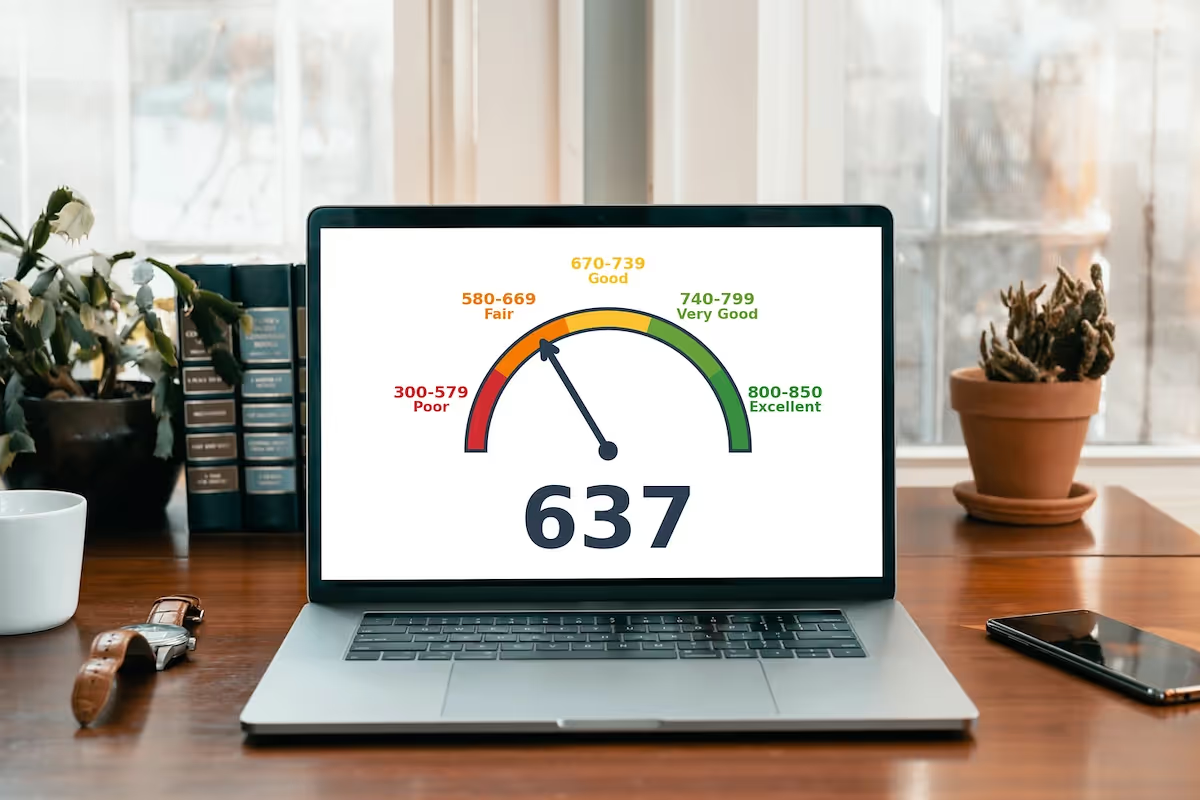
Kudos has partnered with CardRatings and Red Ventures for our coverage of credit card products. Kudos, CardRatings, and Red Ventures may receive a commission from card issuers. Kudos may receive commission from card issuers. Some of the card offers that appear on Kudos are from advertisers and may impact how and where card products appear on the site. Kudos tries to include as many card companies and offers as we are aware of, including offers from issuers that don't pay us, but we may not cover all card companies or all available card offers. You don't have to use our links, but we're grateful when you do!
637 Credit score: What You Need to Know in 2025
July 1, 2025


TL;DR
A 637 credit score is a great foundation to build upon, positioning you for future financial opportunities. According to the FICO model, this score falls squarely within the 'Fair' credit range.
What Does a 637 Credit Score Mean?
A 637 credit score places you in the "fair" category on the FICO scale. While not considered a poor score, it signals to lenders that you may pose a moderate risk. As a result, you might find it more challenging to qualify for loans or credit cards with the most favorable terms, potentially leading to higher interest rates and less flexible repayment options than those offered to borrowers with higher scores.
Think of a 637 score as a solid foundation rather than a final destination. It's a position from which significant financial progress is entirely possible. By taking the right steps, you can build upon this score, opening doors to better lending opportunities and greater financial freedom in the future.
Who Has a 637 Credit Score?
While age isn't a direct factor in calculating your credit score, there is a strong correlation between age and higher scores. Generally, the older you are, the more time you've had to build a positive credit history. According to Experian data from 2023, the average FICO score increases with each successive generation.
- Generation Z (ages 18-26): 680
- Millennials (ages 27-42): 690
- Generation X (ages 43-58): 709
- Baby Boomers (ages 59-77): 745
- Silent Generation (ages 78+): 760
Credit Cards With a 637 Credit Score
A credit score of 637 places you in the "fair" credit range, which can be a mixed bag when applying for new credit cards. While you may find yourself eligible for a variety of cards, particularly those aimed at consumers building or rebuilding credit, you might not qualify for premium rewards cards with the best perks. Lenders are also more likely to offer you a higher interest rate and a lower credit limit until you've demonstrated a longer history of responsible credit use.
Kudos can help you find the best card for your financial situation with its AI-powered tools that analyze your spending habits and stated preferences to generate personalized recommendations. These tools allow you to compare your top options side-by-side and gain insights into how each card aligns with your financial goals, helping you make an informed decision.
Auto Loans and a 637 Credit Score
A 637 credit score places you in the non-prime borrower category, meaning you can likely still secure an auto loan, but not at the most competitive rates. Lenders see this score as a moderate risk, which translates to higher interest payments over the life of your loan compared to applicants with stronger credit histories.
- Super-prime (781-850): 5.25% for new cars, 7.13% for used cars
- Prime (661-780): 6.87% for new cars, 9.36% for used cars
- Non-prime (601-660): 9.83% for new cars, 13.92% for used cars
- Subprime (501-600): 13.18% for new cars, 18.86% for used cars
- Deep subprime (300-500): 15.77% for new cars, 21.55% for used cars
Mortgages at a 637 Credit Score
A 637 credit score puts you in a position to qualify for several types of home loans. According to mortgage loan requirements, this score generally meets the minimums for conventional (620+), FHA (580+), and VA (620+) loans. You may also be eligible for a USDA loan, though some lenders prefer a score of 640. The primary loan type out of reach is a jumbo loan, which typically requires a score of 700 or more.
While you can get approved, your score will affect the terms. Expect higher interest rates compared to borrowers with excellent credit, resulting in a higher monthly payment. On a conventional loan with a small down payment, you'll also likely pay more for private mortgage insurance (PMI). Lenders will view you as a moderate-risk borrower, so your application may face closer scrutiny.
What's in a Credit Score?
Figuring out what goes into your credit score can feel like trying to solve a complex puzzle, but it generally boils down to a handful of key elements. The most common factors include:
- Your payment history, which tracks whether you pay your bills on time, is the most significant factor.
- Credit utilization, or the amount of credit you're using compared to your total available credit, also plays a major role.
- The length of your credit history demonstrates your experience with managing credit over time.
- Having a healthy mix of different types of credit, such as credit cards and installment loans, can positively impact your score.
- Finally, recent credit inquiries, which occur when you apply for new credit, are also taken into account.
How to Improve Your 637 Credit Score
Your credit score plays a crucial role in your financial life, and it is always possible to improve it with consistent effort and the right strategies. Meaningful changes can often be seen within three to six months of developing positive financial habits.
- Monitor your credit reports. Regularly checking your reports from all three major bureaus helps you identify and dispute any inaccuracies that could be dragging down your score. This also allows you to track your progress and ensure your positive actions are being recorded correctly.
- Establish automatic bill payments. Since payment history is the most significant factor in your score, ensuring you never miss a payment is critical for improvement. Setting up automatic payments is a simple way to build a positive payment history and avoid late fees.
- Reduce your credit utilization ratio. This ratio compares your credit card balances to your total credit limits, and keeping it below 30% can significantly boost your score. For a 637 score, paying down balances or even paying multiple times a month can show lenders you manage credit responsibly.
- Address collection accounts. An account in collections can be a major anchor on your credit score, so addressing it is a key step. You can often negotiate a settlement or request a goodwill deletion to help remove this negative mark from your credit history.
As you work to improve your credit, you can use tools like the Kudos browser extension to help you use your credit cards more effectively.
Unlock your extra benefits when you become a Kudos member

Turn your online shopping into even more rewards

Join over 400,000 members simplifying their finances

Editorial Disclosure: Opinions expressed here are those of Kudos alone, not those of any bank, credit card issuer, hotel, airline, or other entity. This content has not been reviewed, approved or otherwise endorsed by any of the entities included within the post.



































.webp)


.webp)






